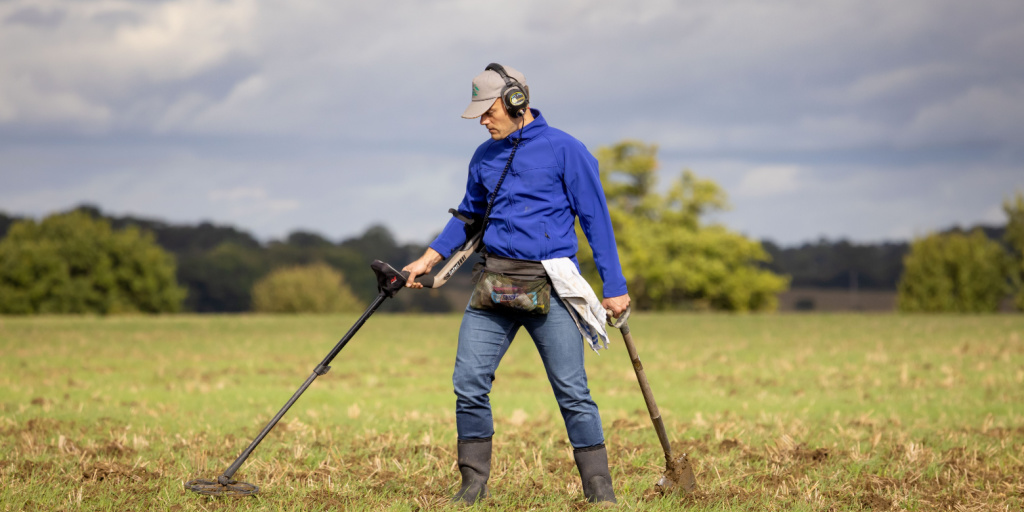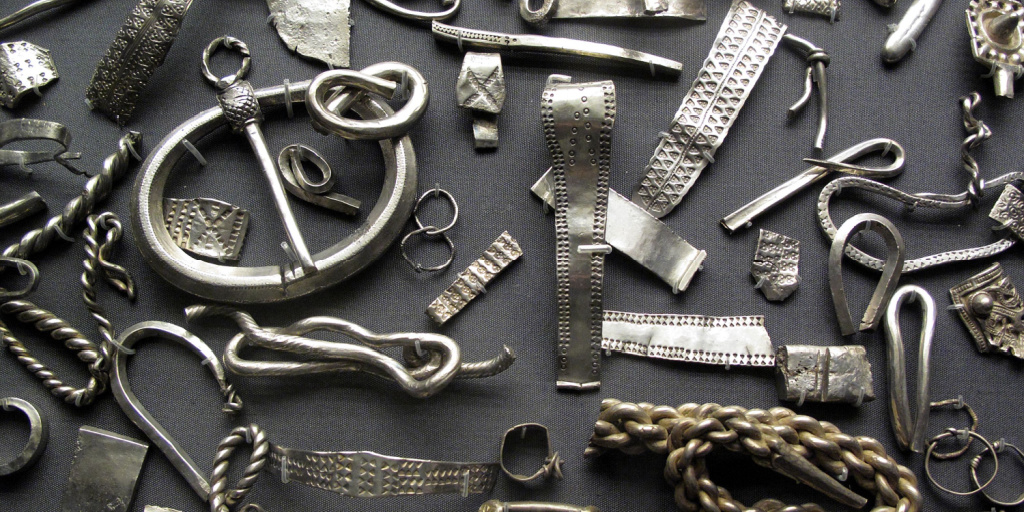What’s driving the rise in popularity of metal detecting, and how likely is an amateur detectorist to be doing a gold dance after just a few sweeps of the coil?

Over the last decade, metal detecting in the UK has become so popular the law has been changed to ensure that antiquities remain in the public domain. But what’s driving the increased participation in a hobby that’s been around for over 50 years?
The origins of metal detecting
The technology behind metal detection dates back almost 100 years, with the invention in 1841 of the 4-coil differential inductor, by Heinrich Wilhelm Dove, a Prussian physicist and meteorologist.
In 1887 Alexander Graham Bell, famed for his invention of the telephone, unsuccessfully used an early metal detecting prototype to locate a bullet lodged in the chest of American President James Garfield, but his device was confused by the metal coil springs of the bed the injured POTUS was lying in.
Shirl Herr submitted a patent for a hand-held metal detecting device in 1924, used in Admiral Richard Byrd’s Second Antarctic Expedition in 1933, looking for evidence of his previous adventure up to a depth of 8 feet.
However, military applications were the main focus of metal detecting devices; in World War I and II they were used to find unexploded ordinance.
Though metal detectors have remained a key tool for military applications and archaeology, metal detecting has more commonly been considered a niche hobby.
The emergence of metal detecting as a hobby
The relative prosperity of the 1950s and 60s in Britain and the move toward suburban living were catalysts for the emergence of hobbies. From playing with train sets in the loft to hammering away in the shed, men found time to pursue recreation.
With the commercial availability of metal detectors, metal detecting joined that list of solitary pursuits that allowed men time to themselves, while women had to content themselves with ‘hobbies’ that were actually just an extension of housework.
Given the relatively technical nature of metal detecting, with the need to discriminate between junk and precious metals, its a pastime traditionally associated with nerds and loners, but there’s always been those smart enough to realise given the rich historical history of the British Isles, there’s plenty of buried treasure if you know where to look.
The increasing popularity of metal detecting
As digital media have taken over our lives, you might expect metal detecting, the preserve of geeky middle-aged men, to have declined in popularity. In fact, the opposite is true.
The Portable Antiquities Scheme, run by the British Museum and encourages the recording of archaeological objects found by members, particularly detectorists, and publishes its findings in an annual report.
The 2021 Portable Antiquities Annual Report (the most recent available) gives us an idea of the scale of metal detecting in the UK.
- There might be as many as 40,000 active metal detectorists in the United Kingdom
- There are approximately 131 metal detecting clubs – an increase of 25% since 2001
- In 2021 there were 45,581 recorded finds – an increase of 21% since 2001
- 96% of the finds recorded by the PAS were by detectorists on cultivated land
- There are now 40 Finds Liason Officers, relied on to record noteworthy items discovered by detectorists
On their own, these figures portray a pastime that is growing but hardly setting TikTok on fire. What is more telling, however, is that in February 2023, the law around how ‘treasure’ is regarded was updated by the Department of Culture Media and Sport, the first change since 1996.
- The legal definition of treasure was updated
- More objects of exceptional archaeological, historical and cultural importance are now protected
- Objects of historical importance more than 200 years old and containing metal will now fit the criteria of ‘treasure’
There has been a huge surge in the number of detectorists, and we want to ensure that new treasure discoveries are protected so everyone can enjoy them.
We are changing the law so that more artefacts uncovered by archaeologists and members of the public can go on display in museums rather than ending up in private hands
Arts & Heritage Minister Lord Parkinson of Whitley Bay
What’s behind the surge in detectorists?
Google Trends, normally a good barometer for increased interest in any subject, doesn’t show any particular change in volume of searches for the keyword ‘metal detecting’ in the UK.
The most recent PAS report tells us there a roughly 40,000 active detectorists, but gives no indication of year-on-year change, so the DCMS statement appears anecdotal.
But as would be expected, quotes from an official government statement have been shared widely throughout the media. If we take the suggestion at face value, we’ll naturally want to unearth why metal detecting has become more popular in the UK.
Cost of living crisis
With everyone’s finances stretched by soaring energy prices, fuelling runaway inflation and interest rates.
There’s been an increase in copper thefts from train lines, catalytic converters from parked cars and lead from rooves. For those not keen on breaking the law, thrift hunting and car boot sales are ways to generate income, so should we be surprised that people turn to treasure hunting?
Media Amplification
With the average cost of a metal detector close to £400, it isn’t for everyone, so it probably falls under the bracket of ‘speculate to accumulate’. And the motivation to have a go at uncovering a precious hoard is often a response to stories in the media focusing on high value finds by novices. Here are some examples:
- Amateur digger finds massive gold nugget with metal detector (March 23rd, 2023
- Dad explains how he’ll spend £648,000 windfall from rare coin he found by accident (January 25th, 2022)
- Mind blowing Bronze Age gold torc found in field (July 15th, 2023)

Part of the Cuerdale silver hoard, buried about 905AD in Lancashire England. The Viking hoard is the largest ever found in Western Europe
A return to history, craft & nature
Technology increasingly dominates our lives, and in the case of Artifical Intelligence, may soon take over. This fear of what the future might bring is leading society to seek comfort from the past.
There’s been a huge revival in craft, illustrated by the popularity of TV Shows like The Great Pottery Throwdown, Sewing Bee and The Repair Shop. While genealogy has seen explosive growth, aided by technology, sites like ancestry.org and also reinforced by BBC flagships like ‘Who do you think you are?’
Craft may have also been boosted by the Covid Pandemic, giving us all plenty more time at home and the need for hobbies to fill it.
Covid also put us more in contact with nature, as walking was one of the only permissible pursuits, while the growing climate crisis has put the natural world at the front of our minds.
The Detectorists TV Show
All of the reasons why metal detecting has enjoyed a resurgence came together in an iconic BAFTA-winning British TV Show, The Detectorists.
The Detectorists added its own unique magic to the hobby, through its depiction of the countryside and the lives of a cast of lovable characters, all members of a mythical metal-detecting club – The Danebury Metal Detecting Club.
Across three series, you get to know dedicated detectorists, Andy and Lance, their uncomplicated lives, their love of nature and their dream of discovering Saxon gold.
The Detectorists has a unique charm, comparable perhaps, with another iconic BBC series about a return to nature, The Good Life, repeated in the Worzel Gummidge reboot, also written by Mackenzie Crook, who plays Andy.
The program doesn’t hide the mundane realities of finding junk – ring pulls and corgi cars – but leaves the audience willing its protagonists to pass their coils over some priceless Saxon treasure that lurks just below the surface.
Survivorship bias, 80/20 rule & the reality of metal detecting
As successful as ‘The Detectorists’ has been at inspiring a new generation of metal detecting enthusiasts, it is a fantasy. The chances of a detecting newbie doing a gold dance are vanishingly small, and those that do are just the results of survivorship bias.
Metal detecting requires knowledge and skill that take years to develop. You might feel you know more than the laymen about detecting, from watching three Series (and two Christmas specials) of The Detectorists, but as with any skill-based pursuit, the path to excellence isn’t linear, but governed by the 80/20 rule.
In other words, 80% of the 45,581 finds in the 2021 PAS report are likely found by just 20% of detectorists, and quite probably even fewer.
This suggestion is backed up by the report’s inclusion that one detectorist alone has self-reported 1,000 finds.
Though metal-detecting can be done in your back garden, the beach or local common, 96% of reported finds in 2021 were on cultivated land, for which you need permission as well as the research to identify where among the 18.5 million hectares of farmland in the UK to start looking.
It cuts both ways, if you don’t follow the rules, your probably more likely to land yourself in trouble than find your fortune. In 2019, two Welsh detectorists got a combined sentence of 18 years for not declaring a Viking hoard of gold, silver and jewels worth a whopping £ 12 million.
By all means, put your coils to the soil and join the growing army of UK detectorists, but best to focus on the benefits to your mental health and appreciation of nature than expect to find anything more valuable than a ring pull or a coat hanger.
No Free Lunch
There is no such thing as a free lunch, but if you’re hungry to find out why, we’re here to help.
You can learn the meaning and origin of the no free lunch concept, as well as the broader philosophy behind the idea that nothing can ever be regarded as free.
We look at our relationship with money and truth, examining all of the supposed shortcuts, life hacks and get-rich-quick schemes.
